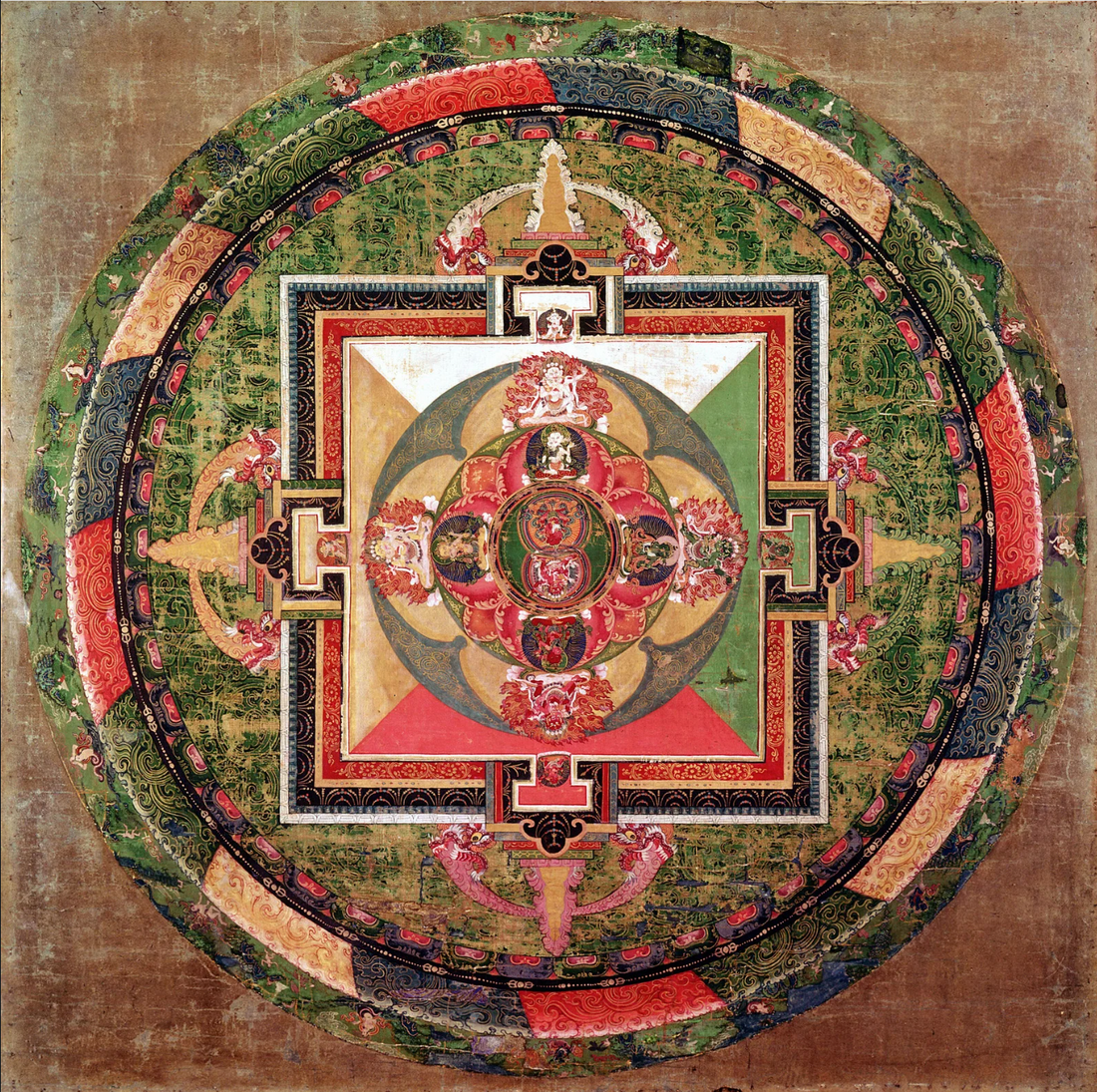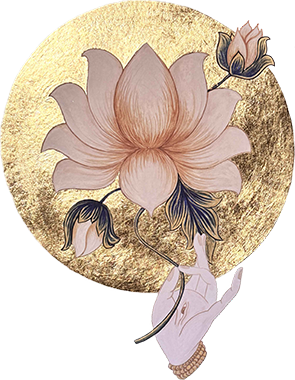
The Healing Power of Mandalas: Science, Spirituality, and Sacred Geometry
Since ancient times, mandalas have fascinated humans with their hypnotic beauty and profound symbolic meaning. More than just circular patterns or decorative pieces, mandalas represent the totality of the universe, the harmony of the soul, and the connection with the divine. Through their perfect geometric forms, these symbols invite us to contemplate life as a system of balance and energy in constant motion.
In diverse spiritual traditions—from Hinduism to Tibetan Buddhism—mandalas have been used as tools for meditation, healing, and consciousness expansion. In the 20th century, Swiss psychologist Carl Gustav Jung integrated them into his therapeutic work, discovering in them a universal language of the unconscious. And today, modern neuroscience confirms what ancient cultures intuited: contemplating or creating a mandala has real power over the brain, capable of inducing calm, emotional balance, and mental clarity.
In this article, we'll explore the history, symbolism, and science behind mandalas, and how their sacred geometry acts as a bridge between the human soul and the cosmic order.
What is a Mandala?
The word mandala comes from Sanskrit and means "circle" or "center." However, its meaning transcends its form: a mandala is a symbolic representation of the universe, an image of divine order expressed in patterns of symmetry and balance.
In its structure, the Mandala begins with a central point, symbolizing the source of all existence, and from there radiates outward in geometric forms that represent the expansion of consciousness. This structure reflects the very nature of the cosmos: everything emerges from a center, grows, diversifies, and returns to unity.
When a person contemplates or works with a mandala, their mind begins to resonate with that inner harmony. The lines, colors, and symmetry act as an energetic map that guides them toward inner silence and connection with the essential.
A historical journey: from ancient temples to the contemporary soul
Mandalas are present in almost all ancient cultures. In India, Tibet, Egypt, pre-Columbian America, and even medieval European art, we find circular representations of the cosmos, time, and divinity.
In Hinduism: Yantras
In Hindu tradition, yantras are sacred geometric diagrams used as instruments of meditation and devotion. Prominent among them is the Sri Yantra, formed by nine intertwined triangles that symbolize the union of the masculine (Shiva) and feminine (Shakti) principles, the creative energy of the universe.
The Sri Yantra is considered a gateway to the inner cosmos, a map of the human spiritual journey from the material plane to enlightenment. Its contemplation or physical presence harmonizes the energy of the environment and the subtle body, balancing the dual forces of the universe.
In Tibetan Buddhism: the mandala as an inner temple
In Tibetan Buddhism, mandalas are representations of the spiritual universe and are constructed with astonishing mathematical precision. Monks make them with colored sand, devoting days or weeks to their creation. When the mandala is complete, it is ceremoniously destroyed, symbolizing the impermanence of all things.
During the process, the monks meditate on compassion, detachment, and universal connection. To observe or participate in this creation is to experience a living teaching: everything that is born, dissolves. Every cycle has a beginning and an end.
Carl Jung and the Mandalas: The Journey to the Center of Being
The meeting of East and West in the understanding of mandalas came about thanks to Carl Gustav Jung, who discovered them during his own processes of introspection. While going through a personal crisis, Jung began drawing circles and symmetrical shapes that he felt emerging spontaneously from his unconscious.
Over time, he came to understand that these drawings were visual expressions of the "Self," the deepest and most balanced core of the psyche. For Jung, the Mandala represented the path to individuation, that is, the process of integrating the fragmented parts of the self into a conscious whole.
"Each Mandala is an attempt by the soul to self-regulate its inner balance." CG Jung
Jung observed that, both in dreams and in meditative states, many people generated circular or mandala images, unaware of their ancestral symbolism. For him, this demonstrated that the mandala is a universal archetype, a structure present in the collective unconscious that reflects the human need for balance and transcendence.
Since then, mandalas have also been used therapeutically as tools for self-exploration and emotional harmonization. Drawing or contemplating a mandala allows one to access deep levels of the psyche, heal repressed emotions, and find one's inner center.
Sacred Geometry: The Hidden Language of the Universe
Sacred geometry is the foundation upon which mandalas are built. It is not just an aesthetic resource, but a universal language of energy, form, and vibration. It is present in everything that exists: from galaxies to human cells, from crystals to flowers.
Each geometric figure—circle, triangle, spiral, or square—has a specific vibrational field that affects our consciousness. Contemplating these shapes activates an internal resonance, reminding us that we are part of a greater order.
The circle: totality and unity
The circle is humanity's oldest symbol. It represents the cycle of life, perfection, and eternity. In a mandala, the circle delimits the sacred space where inner transformation occurs.
The triangle: energy and balance
In sacred geometry, the triangle points to the upward movement of spiritual energy or its manifestation on the material plane. In Hindu Yantras, opposing triangles symbolize the union of the masculine and feminine principles.
The golden ratio and the spiral
The golden ratio, also known as the Phi number (1.618), is a mathematical relationship present in the structure of nature. Shells, sunflowers, and galaxies follow this divine spiral. Mandalas that incorporate this ratio activate a sense of deep harmony because their structure reflects the natural balance of the universe.
The flower of life
One of the most universal patterns of sacred geometry is the Flower of Life, formed by interlocking circles that create a perfect matrix. It represents the interconnectedness of all existence and the fundamental design of creation.
Sacred geometry is not only perceived with the eyes, but also felt with the soul. When contemplating or holding a mandala based on these proportions, the human energetic system responds by vibrating in resonance with the harmony of the universe.
The healing power of Mandalas
From a spiritual perspective, mandalas are instruments of healing and inner transformation. Their circular shape acts as an energetic container that absorbs mental distraction and transforms it into focus, calm, and balance.
When contemplating a mandala, attention is focused on the here and now. This state of conscious presence activates coherence between the heart and mind, reducing stress and anxiety.
On an energetic level, mandalas function as vortices of vibration. Each color and shape resonates with a frequency that influences the body's subtle centers (chakras), harmonizing the flow of life.
Therefore, having a Mandala in your home isn't just an aesthetic choice; it's an energetic and spiritual one. Its presence helps balance spaces, raise vibrations, and remind you of your constant connection with the divine.
The support of science: neuroscience and mandalas
In recent years, science has begun to study the psychological and neurological effects of contemplating and drawing Mandalas.
Research published in Frontiers in Psychology and Art Therapy Journal shows that observing or creating symmetrical patterns reduces anxiety and improves mood. Focusing on the geometric structure triggers the brain to enter alpha waves, associated with deep relaxation and creativity.
A study conducted at Drexel University (USA) revealed that people who spent 30 minutes coloring or contemplating mandalas experienced a significant decrease in cortisol, the stress hormone, and an increase in dopamine, which is linked to feelings of well-being.
Neuroscience knows that repetitive and symmetrical patterns stimulate interhemispheric coherence: the right hemisphere (intuitive, creative) and the left hemisphere (logical, analytical) synchronize. This cerebral balance produces a feeling of calm, mental clarity, and expanded consciousness—effects formerly attributed to spiritual connection.
Thus, modern science confirms what the wise men of the East already knew: Mandalas not only calm the mind, but also harmonize energy and heal the soul.
Mandalas in everyday life
Integrating mandalas into your daily life is a simple and profound way to connect with the divine and bring balance to your surroundings. You don't need to be a monk or an artist; just open yourself to the experience.
- Visual meditation: Spend a few minutes looking at a mandala, breathing slowly. Allow your thoughts to dissolve into its shapes.
- Harmonizing Space: Placing Mandalas in the home or workplace transforms the energy of the environment, generating serenity and clarity.
- Conscious Intention: Each Mandala can be programmed with an intention of peace, love, protection, abundance and act as a vibrational reminder of that energy.
- Silent contemplation: Simply gazing at it in times of uncertainty or tension can reconnect you to your inner center.
In practice, mandalas teach us to remember the balance that already exists within us. They are mirrors of the soul that reflect our divine nature.
Conclusion
Mandalas are more than art: they are maps of the soul and the universe, bridges between science and spirituality, between the visible and the invisible.
Its ancient history, Jung's thought and the discoveries of neuroscience all agree on the same truth: contemplating or inhabiting a Mandala brings us back to the center, to balance and to unity with existence.
Every Mandala we create or contemplate is a living meditation. It reminds us that harmony is not found outside, but within. That the entire universe pulsates within us with the same perfect geometry that shapes the stars.
By inviting a Mandala into our space, we are inviting order, beauty, energy, and awareness. We are remembering, with humility and awe, that we are part of life's grand design.
References
Jung, C.G. – Man and His Symbols
Jung, C.G. (1964). Man and His Symbols . Dell Publishing. (Presents mandalas as universal archetypes of the unconscious, explaining how their contemplation or creation reflects and organizes the human psyche.)
Gyatso, T. – Mandala and Tantra in Tibetan Buddhism
Gyatso, T. (1995). Mandala and Tantra in Tibetan Buddhism . Wisdom Publications. (Explores the use of mandalas in the Tibetan Buddhist tradition, highlighting their meditative, symbolic, and ritual functions in expanding consciousness.)
Frontiers in Psychology – Mandala Drawing, Spirituality, and Mindfulness
Frontiers in Psychology. (2020). Mandala Drawing, Spirituality, and Mindfulness . (Investigates the effects of drawing or contemplating mandalas on mindfulness, emotional well-being, and spiritual connection.)
PMC – Art Therapy and Mandalas in Adolescents with Cancer
PMC. Art Therapy and Mandalas in Adolescents with Cancer . (This study examines the therapeutic impact of mandalas in clinical settings, showing a reduction in anxiety and improved emotional balance in adolescents with cancer.)
Van der Vennet, R. & Serice, S. – The effect of coloring mandalas on anxiety
Van der Vennet, R., & Serice, S. (2012). The effect of coloring mandalas on anxiety . Art Therapy, 29(2), 61–66. (Examines how coloring mandalas reduces anxiety, supporting the idea that simply interacting with mandalas has measurable psychological benefits.)

